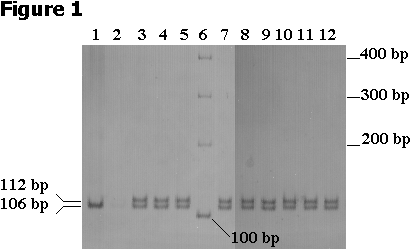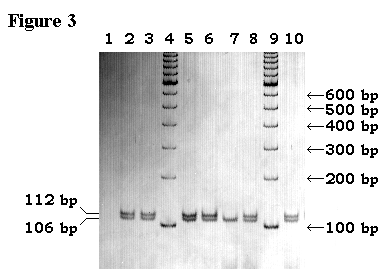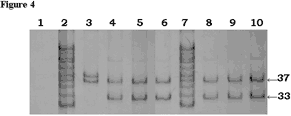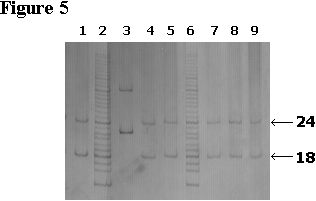

|
Медико-биологический
информационный портал
|
|
для специалистов |
|
ТОМ 4, СТ. X (сc. X) // Апрель, 2003 г.
GENETIC IDENTIFICATION OF SALIVA TRACED ON MATERIAL EVIDENCES A. G. Smolyanitsky, A. I. Smolyanitskaja, M. V. Majatskaja, G. I. Zaslavsky Leningrad Regional Bureau of Forensic Medical Examination, Saint Petersburg, Russia
Introduction
Cigarette butts found either directly at a scene of a committed crime or taken from places associated with a suspectl or victim are often delivered to a forensic biological research department as material evidences for criminal cases. The traditional research biological methods allow in some cases to determine only the group according to юбн system. Other polymorphic protein markers are not applicable to such objects of study. The cytological approaches used to determine the gender of cells from saliva traces on cigarette butts make no more than 5% of positive results according to averaged estimation. The examination of traces left on cigarette butts as evidences are complicated because of a small amount of biological material available for analysis and the extreme effect of environmental factors causing its rapid degradation. One of the most prospective methods to overcome these problems is application of DNA-analysis methods [1].
Materials and methods
In order to obtain the genomic DNA from the saliva cells on cigarette butts we apply several different methods. The classical phenol-detergent method to obtain the genomic DNA contained in the detergent cell is lysis by proteinase K, deproteinization by phenol and chloroform, and alcohol [2]. It is used in everyday activity, but it is highly time consuming. The express method of genomic DNA extraction using chelate forming agent ChelexÒ 100 is applied more frequently. The DNA ready for further analysis can be obtained in 1-1.5 hours [3]. In some cases another prospective approach is used - the method of genomic DNA obtaining and purifying by means of cell detergent-alkaline lysis and specially prepared silicon matrix used for bonding of high-molecular-weight DNA molecules and elution in small volume of buffer (Helix Ltd., St. Petersburg, Russia) [4, 5]. The HLA DQ A1 sequences in samples were amplified using the AmpliType® PM+DQA1 PCR Amplification and Typing Kit (Applied Biosystems, USA) following the manufacturer's recommendations as well as the procedure published elsewhere [6]. Amplification apolipoprotein B and D1S80 was performed using the methods described by Boerwincle et al. [7] and Budowle et al. [8]. The PCRs were carried out in 0.2mL reaction tubes using a 96-well T gradient Thermocycler (Biometra GmbH, Germany). Electrophoretic analysis of the PCR products was performed using the procedure described by Budowle et al. [8].
Results and discussion
As a result of seven years' experience, our laboratory has developed algorithms of work with different biological materials whose traces are found on objects serving as material evidences. The most general approach is presented in the following strategy of research. At the first stage, the possibility to determine the gender of these traces is realized through the research methods on a molecular-genetic level. In order to determine the gender of the cells in the traces on the material evidences, we apply the method based upon the amplification of the amelogenine gene fragment located in the human у and Y chromosomes [9]. To illustrate this, Figure 1 - photo of polyacrylamide gel. The principle of gender determination for study objects is based upon a fact that the length of amplification fragment the of human Y-chromosome is 6 nucleotides more than that of the homologous fragment located in the human X-chromosome. Two fragments (two bands on the phoregram) are typical for male genetic gender with combination of XY sex chromosomes, and one fragment (one band on the phoregram) - for the female genetic gender with two X-chromosomes. Each lane in the gel is the individual DNA sample. In this case, it is the result of the analysis of cigarette buts found at the place of crime. It is often important for investigation to locate the male or female gender indications among the traces of evidences of the biological origin, depending of the circumstances of crime having been committed. Let us study an example of examination where it was sufficient to determine the gender indication for the saliva traces on the cigarette butts to complete the research stage of the crime investigation.
Figure 1
Case 1. A corpse of a woman was found in her apartment. The cause of death was a closed brain injury. The things scattered in disorder with traces of blood on them indicated that a struggle took place in the room. Two men were suspected but they denied their acquaintance with the killed woman. The evidences against them were insufficient. The things with traces of blood and five cigarette butts found in the apartment were delivered into the laboratory. Figure 2 shows the results of the genetic analysis of blood stains and saliva traces gender. The specificity of the gender determination system is so high that it allows to analyze two series of sequent samples on one plate of gel. Lanes 2-5, 8, 10-15 contain two samples of the amplified DNA each; lanes 6 and 9 - 100bp DNA standard for the first and the second series of samples, respectively; lane 1 - the negative amplification control. It was found that the saliva on all of the cigarette butts (lanes 2-6, first series of samples) belonged to the female genetic type. Most blood stains belonged to the male genetic type. As a result of the further genetic analysis it was determined with high extent of reliability that the blood traces belonged both to the first and the second suspected persons. At the same time, according to the results of gender determination and the circumstances of the case, the further identification analysis of the saliva traces on the cigarette butts was not feasible.
Figure 2
According to our data, the unambiguous conclusion on the gender of saliva cells left on cigarette butts being the evidences in different criminal cases and investigated with the use of genetic methods is made in more than 80% the total number of cases. The present method is so sensitive and specific that it can serve successfully as a criterion to estimate whether an object is suitable for any further molecular-genetic analysis. The identification of the traces as belonging to a certain person is solved at the second stage of investigation. The most sensitive genetic analysis systems of Amp-FLP (fragment length polymorphism) and Amp-FSP (fragment sequence polymorphism) series are preferred. The following expertise can serve an example.
Case 2. In the forest belt in the vicinity of a settlement, corpses of a man and a woman were found with numerous incised and stab wounds. As a result of investigation activities, a man was arrested as a suspect of committing this double murder. The man categorically denied the incriminations made against him. five cigarette butts of the same brand were found at the crime scene. The study was begun with the determination of the gender of saliva left on the butts. As Figure 3 shows, the saliva on all the cigarette butts belongs to a male - lanes 2, 3, 5, 6, 10. Lanes 4, 9 are the markers of the molecular weight; lanes 7, 8 are the test samples of definitely female and male types, respectively; lane 1 is a negative amplification control. In order to determine the origin of saliva on the cigarette butts as that belonging to the suspect, the the victim or a third person, further examination was conducted using Amp-FLP systems - Apolipoprotein B 3' hypervariable region (Apo B), D1S80, and Amp-FSP systems - AmpliType® HLA DQ A1 (Applied Biosystem, USA) [10]. The results of the genetic analysis are shown on Figure 4 (юПНб system) and Figure 5 (D1S80 system). Figure 4 shows that the genotypes of DNA obtained from the saliva traces on all the cigarette butts (lanes 5, 6, 8, 9, 10) match the genotype on the suspected person (lane 4) and do not match the genotype of the victim (lane 3). Lanes 2 and 7 contain the allelic ladder for the юПНб system; lane 1 - the negative amplification control.
Figure 3
Figure 4
Figure 5
Figure 5 reflects the results of the analysis according to the D1S80 system. The genotypes of DNA obtained from the saliva cells on the cigarettes (lanes 4, 5, 7, 8, 9) also match the genotype of the suspected person (lane 1). The genotype of the victim also excludes the possibility of his saliva's presence on the investigated butts. Lanes 2 Х 6 are the allelic ladder for the D1S80 system (Applied Biosystem, USA). The additional data confirming the identity of the DNA genotype from the saliva traces on the cigarette butts and the genotype of the suspected person were obtained using HLA DQ A1 system. As a whole, the incriminated probability is 99.99%. Under the stress of evidences the suspect pleaded guilty in the commitment of this crime. Note a the criminal or a victim, other things collected at the crime scene. It is especially important to conduct the search reactions on the saliva presence in cases related to sexual assault cases. In conclusion, the application of DNA-typing analysis to identify saliva traces on the cigarette butts left at the place of crime commitment becomes one of the most essential factors in the disclosure of different kinds of crimes.
References Allen M., Saldeen T. and Gyllensten U. PCR-based DNA typing of saliva on stamps and envelopes. BioTechniques 1994; 17: 546-552. Perkin-Elmer. 1990. AmpliType® User Guide, Version 2. Walsh P. S., Metzger D. A. and Higuchi R. Chelex® 100 as a medium for simple extraction of DNA for PCR-based typing from forensic material. BioTechniques 1991; 10: 506-513. Helix Limited. 1996. Expert 1 - Instruction Manual. Helix Ltd., St. Petersburg, Russia. smolyanitsky A., Andreichuk Y., Kulikov V., Smolyanitskaja A., Majatskaja M. and Zaslavsky G. Application of EXPERT-1 kit for genomic DNA isolation from forensic biological samples: muscle, blood stains, sperm stains and single hairs. Medicina Legalis Baltica 1996; 7: 58-61. Comey C. T., Budowle B. Validation studies on the analysis of the HLA DQa locus using the polymerase chain reaction. J. Forensic Sci., 1991; 36: 1633-1648. Boerwinkle E., Xiong W., Fourest E. and Chan L. Rapid typing of tandemly repeated hypervariable loci by the polymerase chain reaction: Application to the apolipoprotein B 3' hypervariable region. Proc. Natl. Acad. Sci. USA 1989; 86: 212-216. Budowle B., Chacraborty R., Giusti A. M., Eisenberg A. J. and Allen R.C. Analysis of the VNTR locus D1S80 by the PCR followed by high-resolution PAGE. Am. J. Hum. Genet. 1991; 48: 137-144. Mannucci A., Sullivan K. M., Ivanov P. L., Gill P. Forensic application of a rapid and quantitative DNA sex test by amplification of the X-Y homologous gene amelogenin. Int. J. Legal Med., 1994; 106: 190-193. Sajantila, A., Strom, M., Budowle, B., Karhunen, P. J., Peltonen, L. 1991. The polymerase chain reaction and post-mortem forensic identity testing: application of amplified D1S80 and HLA-DQa loci to the identification of fire victims. Forensic Science International 51, 23-34.
|
||||||||||||||
| Размещение рекламы | |
|
| |

 Articles
Articles






